RDP 9004: Saving and Investment in the 1980s 4. Saving and Investment
August 1990
- Download the Paper 2.8MB
The discussion in Section 3 considered a variety of aspects of the partial equilibrium relationship between saving and income. Equilibrium for the economy as a whole requires that aggregate saving be equal to aggregate investment, either continuously (in a closed economy), or in some long-run sense (in an economy with access to international capital markets). An understanding of the determinants of saving thus requires an understanding of the way saving and investment interact. This Section discusses issues relevant to this interaction but does not aim for a comprehensive treatment, because of the considerable overlap with the Tease (1990) paper on the Balance of Payments. Section 4.1 reviews evidence on the determinants of business investment behaviour, and Section 4.2 discusses explanations for the observed relationship between investment and saving.
4.1 Demand for Investment Goods
In principle, characterisations of the investment demand function can be classified into two groups: those which attempt to model investment as a process of adjustment toward some optimally determined capital stock, and those which model the investment flows directly in terms of their presumed short-run determinants. In practice the distinction between these two approaches has not been particularly clear cut. Stock oriented approaches, generally based on neoclassical foundations, have proved inadequate in explaining investment behaviour without building in adjustment lags and various other ad hoc features which bring them much closer to approaches based on direct flow modelling. Nonetheless, a consideration of the long-run predictions of neoclassical investment theory will provide a useful starting point for an examination of the Australian data.
The simplest neoclassical models of demand for the factors of production are completely analogous to demand systems in consumer theory. In the absence of adjustment costs, optimising firms can choose their factor demands independently in each period, and combinations of labour and capital are chosen so as to minimise production costs for any given level of output. The main prediction of such a model is that the degree of capital intensity is an increasing function of the rental price of labour relative to that of capital. For practical purposes, this should be regarded as a long run prediction, since adjustment lags will clearly be of considerable importance.
To compare the qualitative predictions of theory with experience, Figures 39 to 41 show a measure of capital intensity, the capital/output ratio at constant prices, and measures of real factor costs: the cost of labour is measured by the real wage relative to trend productivity, and variation in the cost of capital is represented by movements in the real interest rate[29] (a depreciation rate would have to be added to obtain an estimate of the real level of capital costs). Commenting on the trends in these variables, Carmichael and Dews (1987) noted that changes in capital intensity appeared broadly consistent with the qualitative predictions of the model, with capital intensity tending to rise especially after upward shocks to real wages. It is noteworthy however that capital accumulation seems to have been quite unresponsive to the major changes in real interest rates which took place during the period. In particular the shift from real interest rates close to zero in the 1960s, to the high real interest rates of the 1980s, represents a massive proportionate change in the cost of capital. This may suggest a low elasticity of substitution between factors, but there are other pieces of evidence which conflict with this conclusion. Carmichael and Dews find empirical support for an aggregate Cobb-Douglas production function, implying unitary elasticity of factor substitution, when testing against the more general alternative of a CES function. Russell and Tease (1988) provide evidence for a sizeable real wage effect on aggregate employment, although their equation does not incorporate direct measures of the cost of capital. A further piece of evidence co consider is the relative stability of the profit share of national income. This implies that actual rates of profit earned have been much more stable than the rates of return offered in debt and equity markets.
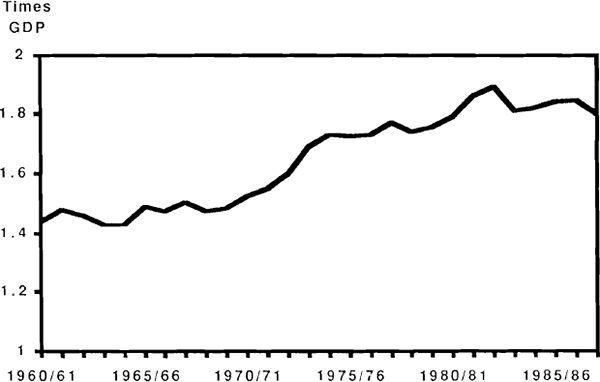
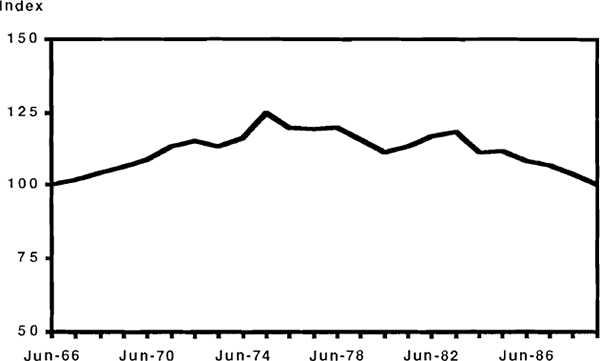
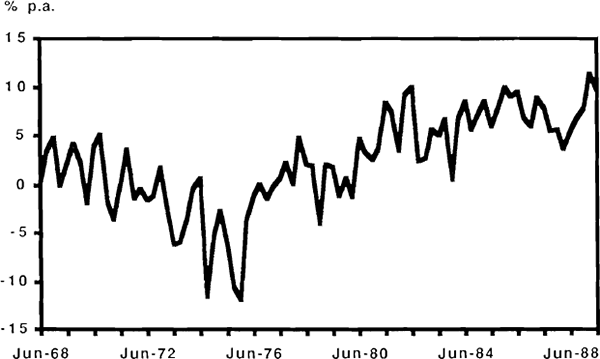
Arguably, the real empirical problem here is to explain why returns in these markets have been able to be out of line with returns in the real economy, rather than to explain why the real economy did not adjust to be consistent with the rates of return offered in debt and equity markets.
In any case, given the relatively slow rates of adjustment of the capital stock and the difficulty in lining up capital stock data with long-run equilibrium conditions, it is fairly clear that explanations of investment need to focus primarily on short-run factors. A popular starting point is the “q theory”, which asserts that investment is positively related to the ratio of the market price of capital to its replacement cost. This can be derived as an extension to the simple neoclassical model with capital adjustment costs, and it follows that the q theory gives the same long-run predictions while potentially explaining temporary deviations in the capital stock from steady state values. Estimates of the q ratio for Australia have been provided by Dews, and are depicted along with data on business investment expenditures in Figure 42. The lagged q ratio does go some way towards explaining the broad trends in investment, particularly the decline during the 1970s. In this respect it is consistent with the conceptually similar measure of the incentive to invest calculated by EPAC (1986), defined as the ratio of expected profitability to the cost of debt finance. Abstracting from the resources boom, the pick up in investment in the second half of the 1980s also seems to match reasonably well the behaviour of the q ratio, although the lag from the rise in q to the recovery of investment was quite long.
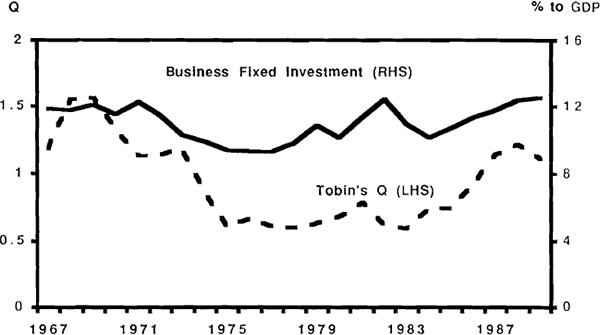
Econometric implementation of the q theory by McKibbin and Siegloff (1987) succeeded in demonstrating a significant role for q, but showed that the q theory on its own does not provide a satisfactory explanation for investment behaviour; explanatory power is considerably enhanced by introducing the level of profits as an explanatory variable. The authors also used an own lag on investment in their equation, thus indicating that the capital stock adjustment costs incorporated in the q theory need to be supplemented by a second order adjustment process on investment itself. McKibbin and Siegloff reported extremely good within-sample fit for their equation, and a significant role for the q variable, but the approach highlights the difficulty of interpreting results once it is recognised that additional factors outside the optimising framework need to be incorporated. For example, movements in q over time are quite closely correlated with company profits, so a q theory may be difficult to distinguish empirically from a “rule of thumb” theory in which firms invest out of retained earnings. Also, the use of an output variable to proxy profitability gives their equation some of the characteristics of the accelerator approach, for which support had been found by Stegman (1982) and in earlier studies reviewed by Hawkins (1979).
Relationships between business investment, profits, and output are illustrated in Figures 43 and 44. These show fairly clearly the empirical regularities identified in the econometric studies. In particular, both of the major downward shocks to the profit share, in 1974/75 and 1982/83, were associated with falls in business investment of similar magnitude, and the upward trend in profits through the middle and late 1980s was matched by rising investment. This of course says nothing about how the profit share itself is determined. Chapman's discussion (1990) puts strong emphasis on the role of wages in influencing profits, and argues that wage setting institutions have had an important influence on factor shares, and hence on investment.
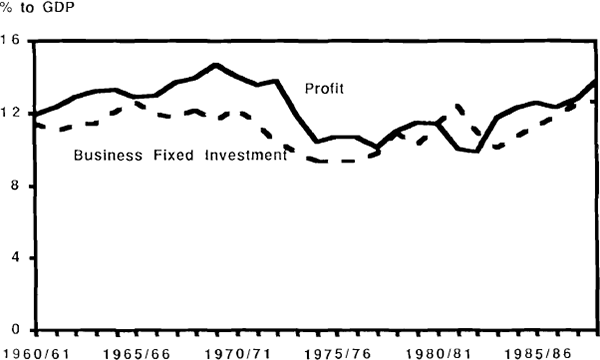
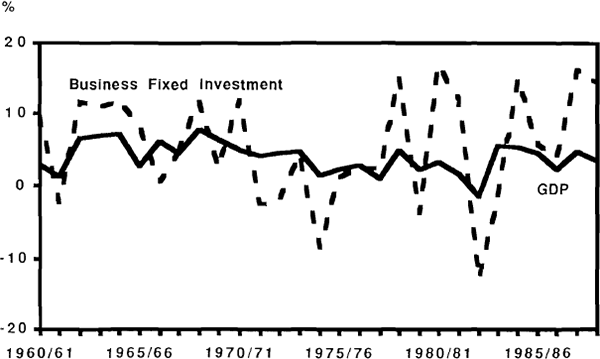
The relationship between investment growth and output growth (Figure 45) should obviously not be regarded as causal, unless it could be established that one variable clearly leads the other. In fact the relationship seems mostly simultaneous, although some tendency for investment to lag seems apparent in the early 1980s. With investment expenditure having a much larger coefficient of variation than GDP, the investment ratio tends to move procyclically; that is, in the same direction as the private saving ratio.
4.2 How Are Saving and Investment Related?
The stylised facts concerning private saving and investment ratios, as outlined in 2, were that inflation-adjusted private saving rates have remained relatively stable, while private investment has shown a modest upward trend relative to income. In the short term, both saving and investment are correlated with the cycle in income, but investment has almost always exceeded saving, implying a current account deficit, and this gap has increased somewhat in the 1980s over the levels typical of the 1960s and 1970s. Given the long-run constraint that accumulated investment is iinanced by accumulated savings (assuming unstable behaviour is ruled out), this raises the question as to how saving and investment are related in the short to medium term, and what sorts of factors could be appealed to in explaining the tendency for saving to fall short of investment.
One approach to these questions, pioneered by Feldstein and Horioka (1980) and applied to Australian data by Tease, focuses on short term correlations between saving and investment ratios. Feldstein and Horioka argue that by definition, this correlation in a closed economy is equal to one, while in an open economy the two variables could be expected to be independently determined. They therefore interpret the saving-investment correlation coefficient as a measure of capital mobility, and find evidence in a number of countries that capital mobility in this sense has been increasing. Other studies, for example Dean et al. (1989), have confirmed this tendency, as has Tease for the case of Australia. Nonetheless these studies generally find that correlations between saving and investment remain quite high (usually around one half) even in the most recent sub-periods when there would appear to be no important regulatory impediments to capital mobility. This should not be considered surprising, for two reasons. First, the saving and investment functions are likely to be influenced by shocks to variables which influence both, most notably income. Secondly, it is possible that deficits have a direct influence on private sector behaviour for a variety of reasons such as credit rationing. If so, the supply of domestic saving will place some degree of constraint on investment behaviour independently of constraints on international capital mobility.
Results of the Feldstein-Horioka type may be useful in describing short-run behaviour, but they are unlikely to take us very far in understanding any persistent tendency for investment to exceed saving, which is fundamentally a problem of intertemporal equilibrium. A useful framework for considering this problem is the model of saving-investment equilibrium used recently by Blanchard (1983) in a study of Brazilian current account deficits.[30] The model economy operates so as to maximise
with respect to the per capita consumption path, subjecl to the accumulation equations
| where | Ct = total consumption |
| Lt = population (assumed to grow exogenously) | |
| Bt = stock of external liabilities | |
| Kt = capital stock | |
| ψ = capital stock adjustment cost function | |
| θ = world real interest rate | |
| F = production function | |
| It = investment | |
| δ = rate of depreciation | |
| ' indicates a time rate of change. |
The solution to this model implies the following steady state properties:
where Y is output, k* is the optimal capital-output ratio and n is the steady state growth rate of the population. The first two of these conditions imply that per capita levels of debt and physical capital are constant in the steady state. The third condition shows the relationship between population growth and aggregate investment: an increase in population growth increases the investment-output ratio by a factor given by the optimal ratio of capital to output. A typical capital-output ratio of about 2 would imply that each 1 per cent increase in the population growth rate increases the investment-output ratio by 2 percentage points.
The above framework has the advantage of being consistent both with permanent income consumption models, and with a q theory of investment, and it imposes long-run consistency between consumption and investment plans. This means imposing the long-run constraint that accumulated investment expenditures must be financed by the accumulation of savings, and ensures that in the steady state the country's foreign liabilities are not growing explosively. A limitation is that this is a one-good model, and therefore abstracts from issues of resource allocation between industries. Essentially the current account deficit or surplus depends only on the relativity between current and permanent incomes, which in turn depends on the level of capital accumulation relative to the steady state. Blanchard shows that for plausible parameterisations and starting values, the model can replicate the broad features of a variety of country experiences.
In the context of such a model, a medium-term tendency toward current account deficits could be given two kinds of explanation. The first is based on under-capitalisation. Broadly speaking, a country whose capital stock is low relative to population will have a high marginal capital productivity and will tend to be a capital importer. Some part of the anticipated gain from higher capitalisation will then be incorporated in permanent income and hence in current consumption, and this will imply a current account deficit; the deficit would be eliminated over time as the optimal capital stock is approached. Undercapitalisation in this sense will occur when a country has a higher than average rate of population growth, or in developing countries which start from an extremely low capital base. As an example of the latter, Hayashi (1989) has argued that the high rates of saving and investment in Japan in the post-war period can be attributed to an initial under-capitalisation relative to the United States economy. A higher than average rate of population growth will also induce higher investment levels in order to maintain the per capita capital stock. There is no corresponding mechanism linking population growth (via immigration) and saving. Population growth therefore tends to widen the saving-investment gap.
A second type of explanation for a persistent saving-investment gap is based on distortions to microeconomic incentives, due in particular to the tax structure. Here the argument is essentially the same as before, but instead of the deficit representing a natural transition to the optimal capital stock, it is assumed that the tax system encourages a bringing forward of consumption or investment spending relative to the optimum.
Both of these potential explanations have a certain amount of appeal in Australia's case. The under-capitalisation hypothesis is plausible because of Australia's high population growth relative to that of comparable developed countries, and because there has been a steady increase during the past 30 years in the proportion of the population of working age (see Table 8). Between 1960 and 1989 the working age population rose from 61 to 66 per cent of the total (close to its projected peak), almost certainly implying an increase in the demand for capital relative to the population as a whole. This effect would have been reinforced by a trend increase in the labour force participation rate. Consistent with these observations, Carmichael and Dews (1987) note that the rate of investment per person in Australia has generally exceeded the OECD average. Parmenter and Peter (1990) provide support for the operation of an under-capitalisation effect arising in the specific case of a population increase due to immigration.
Although these considerations give plausibility to the under-capitalisation hypothesis as an explanation for external deficits, the hypothesis is inherently difficult to substantiate because it refers to under-capitalisation relative to some normal level of capital intensity in comparable countries, and presumably the norm is changing as technology changes. Comparisons between countries are in any case difficult to make because of differences in the mix of industries, which presumably have differing capital requirements. F. Gruen (1986) however argues that the post-war decline in Australia's international ranking in terms of per capita income, is prima facie evidence of a relative decline in capital intensity.
Tax distortions also seem a plausible contributing factor to the saving-investment gap. In addition to those aspects of the tax and benefit system relevant to private saving, discussed in Section 3.5, it has been argued by a number of researchers that there are important distortions on the investment side. Studies by Macfarlane (1989) and by EPAC (1989) have considered the implications of the interaction between inflation and taxation, as did an earlier study by Carmichael and Stebbing (1983). The main point raised by Macfarlane concerned the tax deductibility of nominal interest costs which, for a given real interest rate, tends to increase the incentive to invest and reduce the incentive to save as inflation rises. The EPAC study focused on the question of whether or not this feature of the tax system would lead companies to prefer debt over equity finance, and concluded that following the introduction of dividend imputation, the tax system has been roughly neutral in its impact on the financing decision; this however has no direct bearing on the aggregate investment decision or on the size of corporate and household deficits, and does not negate the point that nominal interest deductibility reduces effective interest rates when inflation is high. A related distortion arises from the asymmetric tax treatment of nominal interest and capital gains, the latter being taxed only in real terms. This treatment would imply an increasing incentive to invest in nominally appreciating assets (including physical capital) as inflation rises, although obviously not to the same extent as would have been the case when capital gains were largely tax free. The quarantining provisions on negative gearing, operating between July 1985 and July 1987, represented a partial attempt to offset this distortion as it related to investment in buildings.
In assessing the net effect of these and other tax distortions, it is important to recognise that distortions are present to some degree in all economies. If all countries operated a tax system which penalised saving and subsidised investment, the theoretical net effect would be to drive up the pre-tax real rate of interest to the point consistent with saving-investment equilibrium, with no net effect on capital flows. The critical question is therefore whether or not the domestic and external tax systems interact in such a way as to provide a net incentive for the Australian private sector to import capital. This question cannot be fully answered without a detailed international comparison of tax systems. However, in at least one case, namely the tax treatment of nominal interest, the direction of the net effect seems to be unambiguously toward capital importing. The reason for this is that the size of the penalty on savers, and the subsidy to investors, depends in each country on the local inflation rate; thus the net effect is in the direction of encouraging capital flows from low inflation to high inflation economies.[31] The size of this implicit subsidy on external borrowing would be equal to the inflation differential times the relevant tax rate, which would amount in Australia's case to a subsidy of about 2 percentage points on the interest rate. Whether this is large enough to have a noticeable influence on behaviour is another question.
In summary, both population growth and tax distortions potentially offer plausible explanations for the medium-term tendency for investment to exceed saving in Australia. At this stage, evidence as to their relative contributions is not available, and this should be considered an important topic for further study, since the policy implications of the two hypotheses are very different. A further point to note is that neither explanation provides an obvious reason why deficits should have increased in the 1980s. In particular the biases arising from the tax system have probably been reduced during the decade. In this regard it would be necessary to appeal to some further factor such as financial deregulation, which may have enabled the private sector to take greater advantage of existing incentives to finance investment out of borrowings.
Footnotes
After-tax real rates are discussed by Carmichael (1990). [29]
Blanchard and Fischer (1989) discuss similar models, and show that results obtained using the representative agent assumption such as described here can be replicated under assumptions of atomistic competition. [30]
Inflation induced tax distortions are discussed further by Carmichael (1990). [31]


